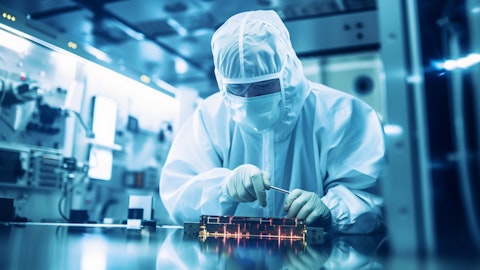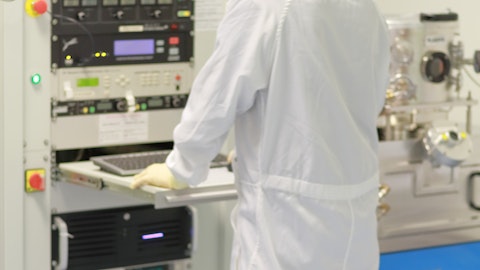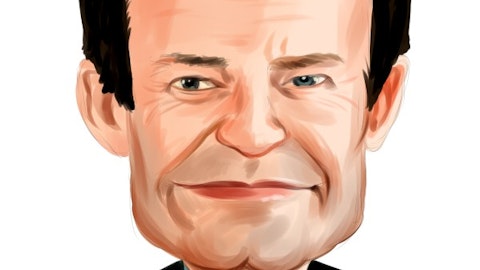Michael Hurlston: Number 1, we don’t break it out. I think that now we’ve tried to give you and the rest of the folks that follow the stock a better look into the business by breaking out Core IoT. But within Core IoT, we certainly don’t break out what’s processors and what’s wireless. I will say it’s mostly wireless. I mean, today our processor line is there and we talked about some wins in that space in the prepared remarks. But generally, Wi-Fi is the story. Wi-Fi is doing well. We’re getting that business back on track. It was plagued by quite a bit of inventory. And now we’re starting to see that business come back in a fairly appreciable way. So we feel pretty good about that. For us, you touched on it, you might have a different question around it when we get there.
But Wi-Fi7 is we haven’t launched Wi-Fi7. Wi-Fi7 generally still isn’t available from an infrastructure standpoint. Our biggest issue right now is actually transitioning the customer base from Wi-Fi5 to Wi-Fi6. And we’ve got a full suite of Wi-Fi6 products. Our mix is still less than 50% on Wi-Fi6. So we see a pretty significant opportunity to transition the customer base from Wi-Fi4 and 5 to 6. We will, as I said in the prepared remarks, be introducing a Wi-Fi7 chip at the end of the year. And look, we think we’re going to be first for an IoT class product that incorporates the Wi-Fi7 standard. But I think that’s going to be a while before it really grabs any sort of meaningful foothold.
Kevin Cassidy : And on the docking station, is enterprise is slow, but is there inventory on top of that? Does the inventory still have to be depleted? And we’re just waiting for enterprise to come back and then it might still be a quarter or so before we see that business growing again?
Michael Hurlston: Yes. So I mean, first, Kevin, it did grow. So I think we’re coming off the bottom on dock. There still are pockets of inventory. I think I may have said to a previous question that we have kind of 2 halves of the business, as you know well, the DisplayLink and DisplayPort sides of the business. The DisplayLink, which is the Dock Anywhere, has a bit more inventory that I think we need to work through. And that’s a big piece of our gross margin profile. So that’s been particularly slow. The DisplayPort side of the business, I think we’re probably at equilibrium now. That’s the piece that kind of grew on quarter. And that’s facing more of this demand challenge that I highlighted in Quinn’s question, where we see pretty suppressed demand across the enterprise and automotive portfolio. As demand normalizes, we’d expect that docking business universally to pull back up.
Operator: Our next question is from Krish Sankar of TD Cowen.
Krish Sankar: Michael, I had 2 of them too. First one on gross margins, you keep hearing about lagging as foundry vapor prices have come down, but you’re not seeing any gross margin benefit for you. So I’m just kind of curious, is your gross margin really tied to volume or in the Enterprise Auto segment or, is there something else going on?
Michael Hurlston: I mean, I think there’s 2 factors for us. One and the dominant factor is mix and we’ve you and I have talked about this a couple of times. And our mix for our gross margin profile, the enterprise and automotive is our strongest driver. And again, there’s mixed issues within enterprise and automotive. But the slowest part right now of our E&A business is also our highest margin. That’s comment one. Comment two, I would agree with you that the foundry pricing seems to move a lot. We are partnered with one particular foundry guy. As you know, we kind of moved our strategy to be very, very heavily weighted toward one supplier. That one supplier has been the slowest to move on pricing. So I would say that we are hearing the same things that you are that there are price, there’s price relief across the semiconductor supply chain.
I think that’s less true with some of the bigger suppliers. And we are certainly partnered with one of the biggest and that particular supplier has been less apt to move and respond to kind of current pricing conditions.
Krish Sankar: And then a follow-up, thanks for some of the color you gave on the Astra platform. It seems like you’ve seen some Edge IoT devices for AI come out lately, but the issue seems to be around latency. From Astra’s standpoint, do you require a smaller and more optimized AI model to run full inference on devices or you think the model sizes today, you can actually run full inference with no latency with your actual platform?
Michael Hurlston: Look, I think on Astra, well the technology, we can’t run large language models or gene sequencing or things like that. But within the 2 and 4 core portfolio, we can run a whole gamut of AI models. And those AI models are large in size. They come from a traditional AI source, such as an NVIDIA being trained in the data center, our trick is we have a compiler that takes those models and compiles them into our code size. And at least as far as I understand it, and we’ve spent a lot of time on this with our division head, those models run without latency problems. I mean, that’s one of the advantages that we highlight in this business that we have very little latency, high security and high power efficiency across this product line. And that’s one of the advantages we bring. Rather than having to go back and forth to the data center, you can run these AI models on chip. And obviously that has significant latency advantages.
Operator: Our final question comes from Peter Peng of JP Morgan.
Peter Peng: Just for the wireless portion in your Core IoT, it was kind of at that $200 million revenue run rate. I think where are we and are you still confident in getting back to those levels?
Michael Hurlston: Yes, Peter. No, I mean, we are obviously very confident in being able to get back to those levels. I think like we’ve been talking about with enterprise and automotive, there is a demand issue in the wireless. It’s some of it’s consumer facing. We actually have quite a bit of it that’s enterprise facing. Our inventory as we said in the prepared remarks is largely worked through. So now it’s a little bit of a suppressed demand environment. We’d expect that we continue to work through that demand will return and when it does we’d expect that to go to $200 million and beyond. And then in addition as we talked about, we have a lot of new products, our new products that are coming online and we also have new design wins that are coming online.





